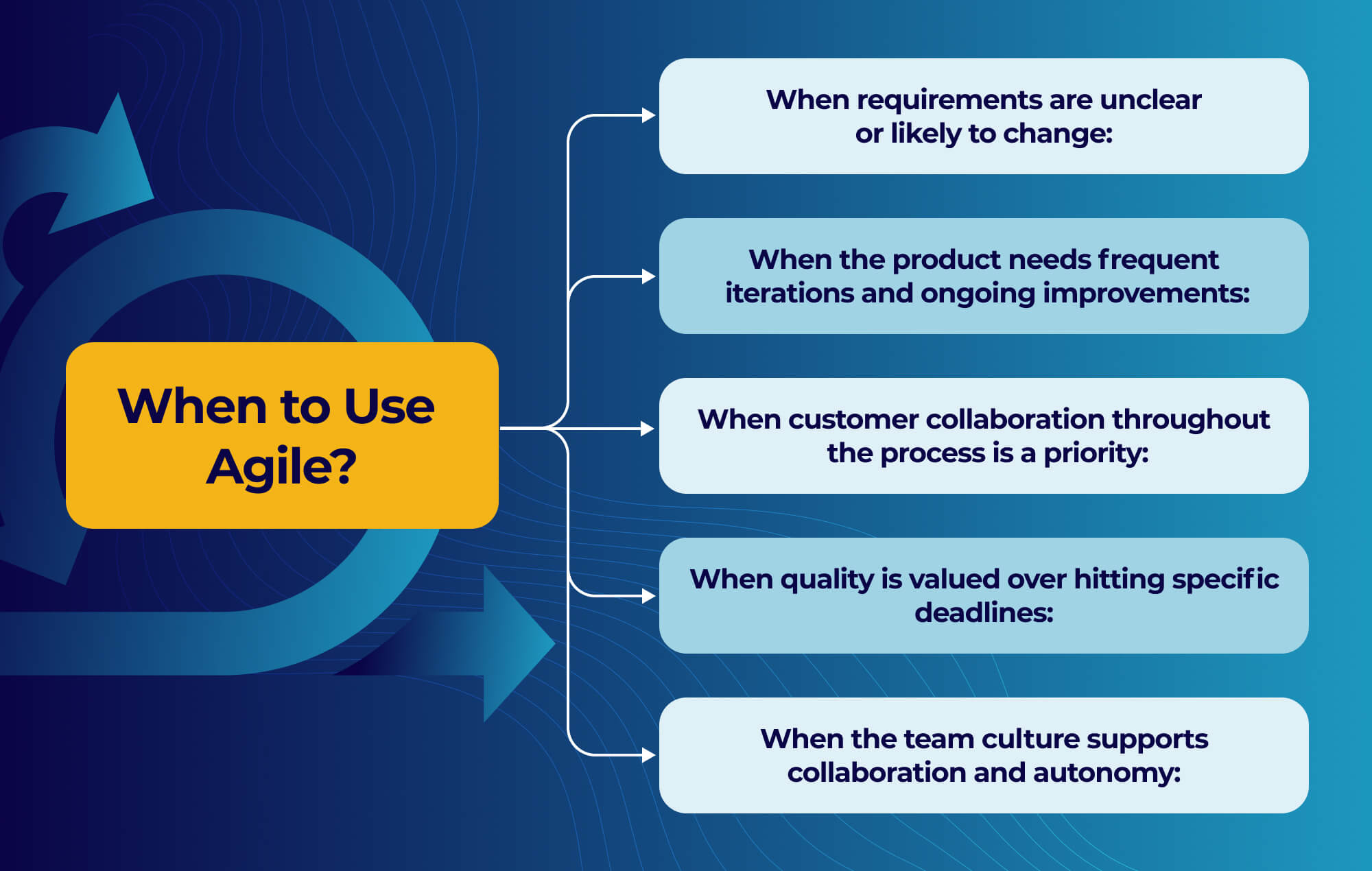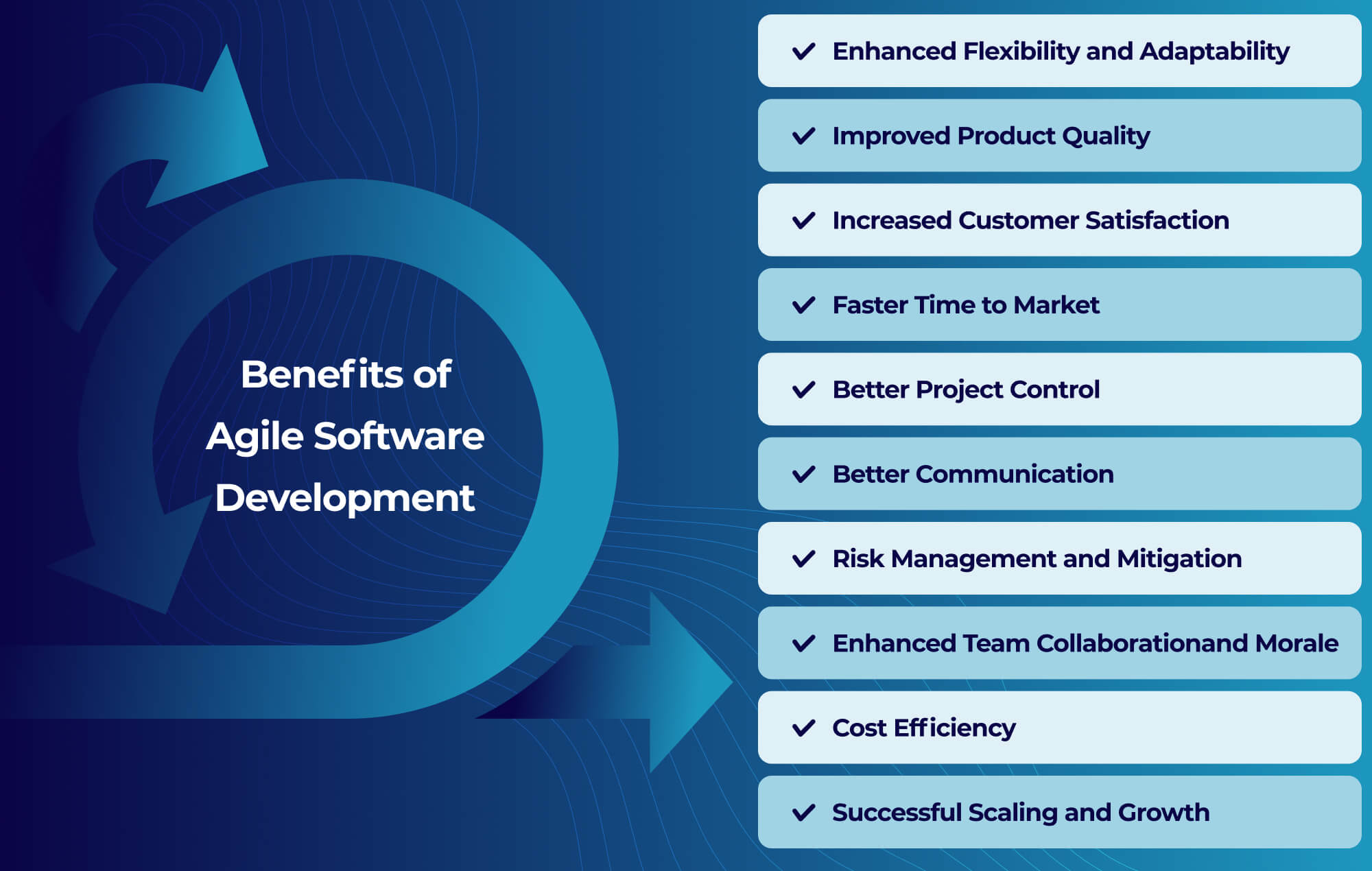Table of Contents
The software development landscape has undergone a monumental shift over the past two decades thanks to the introduction and benefits of Agile software development. Created out of frustration with traditional waterfall development, which focuses on linear sequential phases, Agile practices have now become the norm across most industries.
This is because, by breaking the development process into iterative steps, Agile offers a lightweight, flexible approach that produces higher-quality software and ensures customer satisfaction. With its emphasis on constant feedback and continuous improvement, the Agile methodology ultimately unlocks a variety of powerful benefits, from enhanced communication to faster time to market.
In this article, we explore the top benefits of Agile software development, and discuss how you can leverage the practice to achieve better project control and increased efficiency. By the end, you’ll clearly understand how Agile methodologies can optimize and accelerate your software projects. So, let’s dive in and transform the way your team collaborates and delivers.
What Is Agile Methodology?
Agile methodology is an iterative approach to software development that values responding to change, frequent delivery of working software, close collaboration between teams and customers, and individuals and interactions over processes. It refers to software development approaches based on the values and principles expressed in the Manifesto for Agile Software Development.
Some of the key principles outlined in the manifesto include:
- Iterative Development: Teams develop software in short cycles called sprints, delivering functional incremental versions in each one. This process allows for the swift incorporation of customer feedback and ensures sustainable development.
- Continuous Planning: A project’s development can easily change and adapt based on evolving requirements rather than following a rigid plan.
- Rapid Delivery: Early and continuous software delivery helps developers test ideas with customers, increasing overall satisfaction.
- Close Collaboration: Daily cooperation between business teams and developers fosters collaboration and improves project quality.
- Flexibility and Adaptability: Welcoming changing requirements even late in development offers flexibility not found in other methodologies.
By working in small but complete increments, teams can modify and deliver working software repeatedly over the software development lifecycle in a matter of weeks. This step-by-step process essentially provides a framework for responding to unpredictability through iterative work and rapid feedback cycles.
When to Use Agile Software Development?
With so many software development models available, it can be difficult to determine which approach is best for your project. Agile is exceptionally well-suited for certain types of software projects, while traditional plan-driven approaches work better for others. So, when should you implement Agile practices?
- When requirements are unclear or likely to change: In many software projects, it can be difficult to fully define all requirements upfront or anticipate how they may evolve over time. Agile is built to adapt and handles these situations with evolving requirements exceptionally well compared to predictive models that lock in requirements early.
- When the product needs frequent iterations and ongoing improvements: For software that will be enhanced and refined on an ongoing basis post-launch, setting up a project structure to enable frequent iterations is key. Agile’s iterative approach, with work done in sprints, makes it easy to continuously update and improve products based on user feedback.
- When customer collaboration throughout the process is a priority: In some development projects, getting frequent input and sign-off from customers is critical to success. With constant user involvement and approval driving development, Agile enables tight customer collaboration to ensure the right product is built.
- When quality is valued over hitting specific deadlines: For mission-critical applications where quality and correctness cannot be compromised, shipping working software incrementally reduces risk compared to big-bang all-or-nothing launches. Agile allows teams to properly test and QA each incremental release.
- When the team culture supports collaboration and autonomy: Agile works best with highly collaborative, self-managing teams. Self-organizing Agile teams thrive in environments that empower them with autonomy and support tight collaboration across functions like design, development, and testing.
On the other hand, plan-driven software development approaches may be preferable for:
- Projects with crystal clear, stable requirements
- Rigid constraints demanding high upfront certainty
- Compliance with strict standards or regulatory requirements
- Environments uncomfortable with a less structured framework
Agile is fit for purpose wherever flexibility and responsiveness are beneficial. While no single solution suits all scenarios, Agile has proven itself across the majority of modern software projects. Evaluating your priorities and constraints will help you determine if Agile practices are a good fit for your organization.
Benefits of Agile Software Development
The Agile methodology and its various frameworks like Scrum and Kanban provide immense advantages over traditional plan-based approaches. Agile practices introduce lightness, flexibility, and the ability to adapt quickly in a world where business requirements evolve rapidly.
Adopting Agile delivers numerous quantitative and qualitative benefits, not just for the software but also for teams and organizations deploying it. The empirical process control built into Agile through continuous feedback and optimization drives tangible improvements, from boosting product quality to reducing costs.
Enhanced Flexibility and Adaptability
A standout benefit of Agile software development is the flexibility and adaptability it provides teams. With iterative delivery, teams can reprioritize requirements in each sprint without severely impacting budgets or timelines. Continuous stakeholder feedback is also built-in, facilitating quick adaptation of product roadmaps based on user inputs.
Due to the modular architecture focusing on incremental completions, alterations can occur relatively smoothly, even in later lifecycle stages. The emphasis on welcoming changing requirements enables building the right product. Agile inherently provides an excellent platform for entrepreneurial, adaptable environments dealing with ambiguity.
Improved Product Quality
By emphasizing early and continuous testing driven through automated checks, Agile projects achieve notably higher quality compared to traditional plan-driven approaches. Through repetitive testing cycles, defects get identified much faster, reducing technical debt and increasing the project’s stability.
Integrating code testing activities across designers, developers, and testers also improves quality by preventing downstream issues. As per industry surveys, this collective ownership through collaborative work translates directly into superior software, with about 42% of teams confirming considerable quality improvements after Agile adoption.
Increased Customer Satisfaction
Agile methodologies deliver substantially higher customer satisfaction levels by prioritizing customer collaboration through constant feedback loops. Users provide regular inputs on working software increments rather than just upfront. This process incorporates customer perspectives iteratively, aligning products closely to actual needs.
Ongoing user approval helps ensure that functionality meets demands without needing last-minute requirement changes. This empirical approach generally produces software that generates much happier clients and users. In fact, research from McKinsey indicates teams adopting Agile practices have over 30% higher customer satisfaction on average.
Faster Time to Market
Agile projects deliver initial working product versions and update release cycles much quicker than traditional development. Stakeholders realize tangible outcomes rapidly by focusing on modular milestones frequently released in sprints, allowing organizations to seize opportunities faster.
For instance, according to Harvard Business Review, Enterprise Advanced Marketing leveraged Agile practices to compress production cycles by up to 75%. This difference adds up substantially over the product’s lifetime. Updates also get built and deployed faster using Agile since teams continually slot new requirements into upcoming sprints.
Better Project Control
Rather than focusing on yearly plans, Agile provides continuous indicators for early course corrections, enabling much tighter project control than other methodologies. For example, by using cadences of fixed-length sprints conducted consistently, Agile ensures precise visibility into team velocity and delivery rates.
Additionally, real-time reports and progress metrics, defect rates, and story point burndown, coupled with routine sprint reviews, offer complete, transparent insights into project performance. This data-informed progress tracking allows stakeholders to accurately gauge if the team will achieve set delivery targets, as risks can be identified early in the process.
Better Communication
Agile models mandate close-knit team collaboration through ceremonies like daily scrums, improving communication and keeping everyone on the same page. By bringing cross-functional team members together on a regular basis, Agile prioritizes daily interactions to foster open, flowing conversations and ensure goal alignment.
After all, having direct conversations to highlight blockers, coordinate dependencies, and assess progress is exponentially more effective than using isolated progress emails. These Agile rituals also build trusting and transparent relationships between business teams and delivery groups, creating a harmonious environment needed for project prosperity.
Risk Management and Mitigation
Agile methodologies enable superior risk management compared to traditional sequential models in two key ways, particularly in addressing software development risks. Firstly, by developing software iteratively through small increments, any single iteration poses a limited downside, even if unsuccessful. Secondly, adapting requirements frequently allows teams to incorporate contingencies rapidly.
Continuous testing and stakeholder feedback also help identify issues early, triggering prompt mitigations before such risks snowball. What’s more, teams can address problems within the current or next sprint cycles through collective troubleshooting policies like swarming.
By embracing the certainty of uncertainty, the Agile approach enables developers to structure projects to detect and tackle unseen challenges swiftly. This means that, instead of rigid plans leading to cascading failures when disrupted, Agile systems limit blast radius while providing fast-response inbuilt mechanisms to combat risks, increasing project resilience.
Enhanced Team Collaboration and Morale
The cooperative nature at Agile’s core fosters fantastic teamwork, communication, and workplace satisfaction, directly strengthening execution ability and output quality. For example, by prioritizing collaborative rituals like standups, retrospectives, and showcases, the Agile method helps bond teams and enhances camaraderie.
Working in autonomous self-organizing units instead of specialized silos also boosts morale markedly through shared ownership. Besides improving job satisfaction, better collaboration translates plainly into superior functioning. This is because frequent alignment, cooperation, and support leads to remarkable team coordination and productivity, accelerating outcomes collectively.
Cost Efficiency
Agile promotes tremendous cost optimization in several ways, making it ideal for custom software projects. For instance, prioritizing by business value ensures that a precious budget gets allocated to the most critical features. Short iterative cycles also bring direct, measurable value from each sprint without bloated budgets for delayed returns.
Additionally, timeboxed development phases prevent teams from getting stuck on complex tasks, burning budgets indefinitely. Scope also gets formally negotiated every few weeks, keeping teams lean and efficient. Even customizations get simplified through reusable component libraries, curtailing expensive one-off development.
Ultimately, by spending wisely on essentials that create end-user value, Agile excludes unnecessary features that bloat application costs without proportional benefits. This process leads to remarkably prudent expenditure, improving development velocity while cutting costs and maximizing software ROI.
Successful Scaling and Growth
While small co-located groups can easily coordinate Agile execution, larger dispersed teams can achieve similar velocities through frameworks purpose-built for scaling, such as SAFe and Scrum of Scrums. These operate via a train model with multi-layered sync-up forums for alignment between numerous smaller Agile pods working in unison toward a shared business goal.
Such structured scaling paired with strong automation allows growing product portfolios, digitization programs, and online platforms to accelerate release rates dramatically despite ballooning team sizes. So, with the right scaling recipes, Agile provides outstanding templates for hyper-growth.
Advantages of Agile Development
As you can see, Agile shines on many fronts; however, contrasting the development method with other dominant approaches helps truly reveal its distinct strengths. By evaluating Agile against methodologies like Waterfall, Lean, and PRINCE2, you can easily see its benefits across various project environments.
Agile vs. Waterfall
Unlike linear sequential Waterfall, which focuses on upfront requirements gathering and planning, Agile emphasizes responding to change by building fast deployable increments. This differentiated focus allows Agile teams to incorporate feedback and adapt swiftly throughout development, making it the perfect choice for shifting priorities.
Agile vs. Lean
Although Lean shares Agile’s goal of driving out waste from processes, it takes a tools-based approach centered around metrics and rigorous scientific thinking. Agile, on the other hand, focuses more on cultural change using collaborative rituals for flexibility. So, while Lean suits data-driven improvement initiatives, Agile provides lightweight frameworks for complex software projects.
Agile vs. PRINCE2
Projects in Controlled Environments, otherwise known as PRINCE2, underpins structured project governance for controlled environments. With pre-defined stages, tolerance levels, and management boards, it ensures rigorous compliance, which is crucial for enterprises. Agile, however, offers a more adaptive substitute, sacrificing precision for quicker maneuverability fitting fast-paced domains.
Agile Software Development From Idea Maker
The immense growth of Agile marks the revolution it has sparked across the modern technology landscape. Agile practices have clearly demonstrated better, faster project outcomes in software-driven domains demanding constant innovation.
While no methodology suits every situation perfectly, Agile provides excellent advantages by embracing uncertainty and empowering autonomy for optimum results. The exceptional customer alignment, rapid iterations, high adaptability, and tighter control make Agile methodologies a reliable route to prosperity.
From enabling resilient future-ready systems to fostering happier teams and heightened efficiency, Agile profoundly enhances how organizations operate at scale. As the only constant is change, software delivery needs to evolve from rigid requirements plans to adaptable roadmaps welcoming continuous constructive feedback.
If you’re looking for an expert partner to help implement Agile frameworks and methodologies customized for your software project, please reach out to the specialists at Idea Maker. Our collaborative engagement models focused on transparency, velocity, and value creation are proven to create successful outcomes.















